Module 2 Unit 4 Numbers Period 3 Reading 主题阅读 牛津上海版八年级英语上册 课件 (共43张PPT)
文档属性
| 名称 | Module 2 Unit 4 Numbers Period 3 Reading 主题阅读 牛津上海版八年级英语上册 课件 (共43张PPT) | 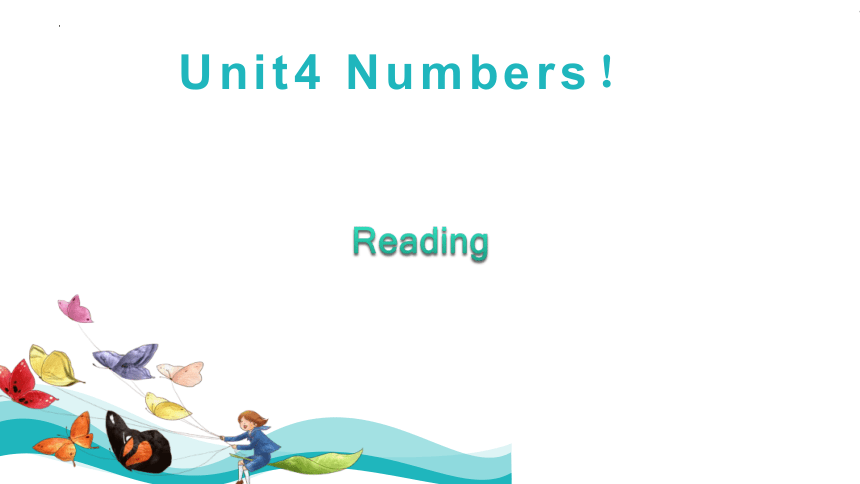 | |
| 格式 | pptx | ||
| 文件大小 | 19.3MB | ||
| 资源类型 | 教案 | ||
| 版本资源 | 牛津上海版(试用本) | ||
| 科目 | 英语 | ||
| 更新时间 | 2023-09-23 15:14:38 | ||
图片预览

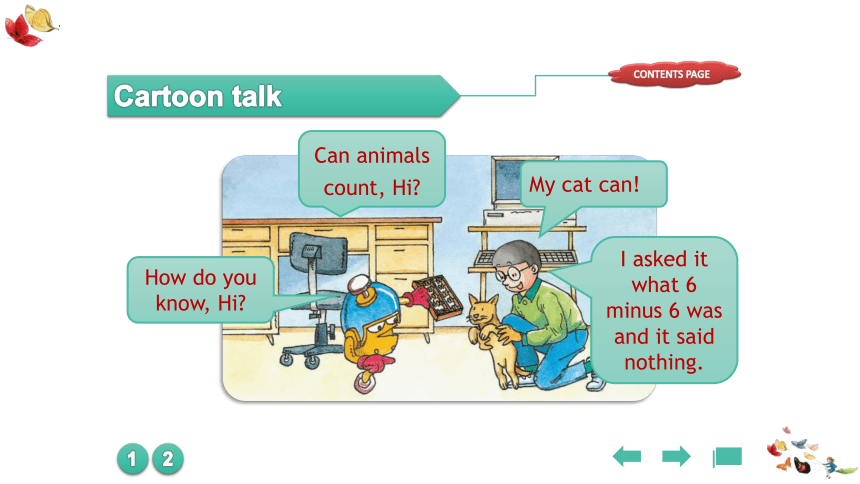
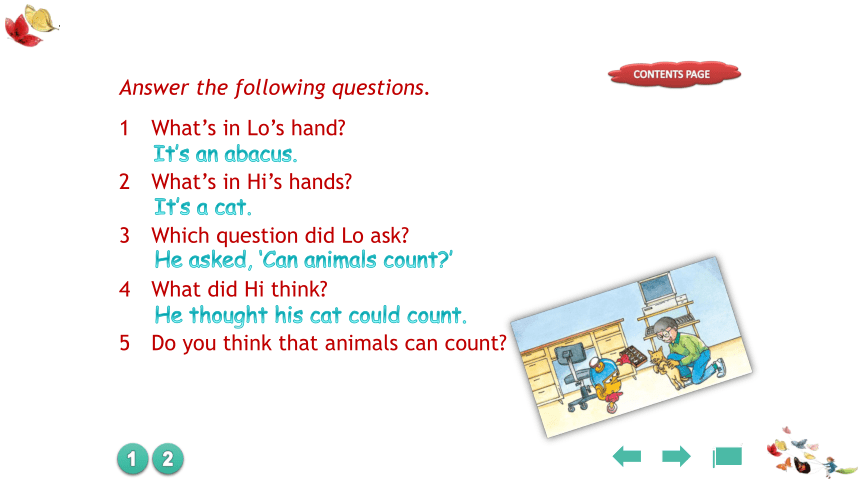
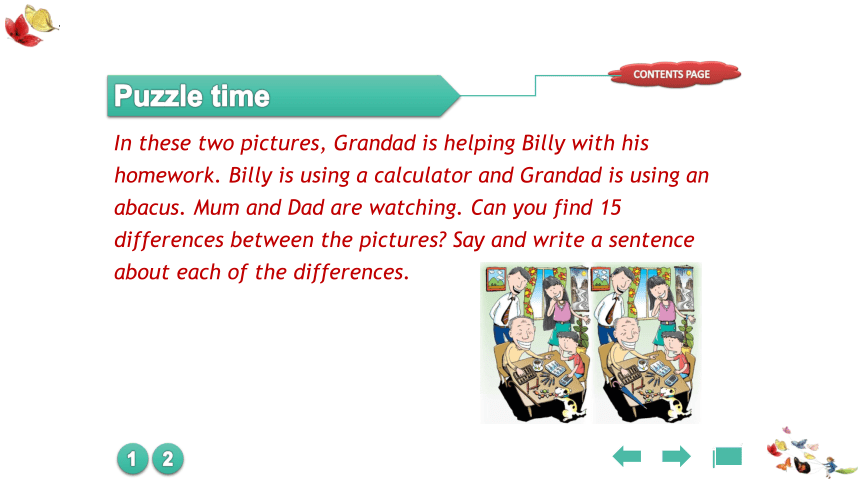
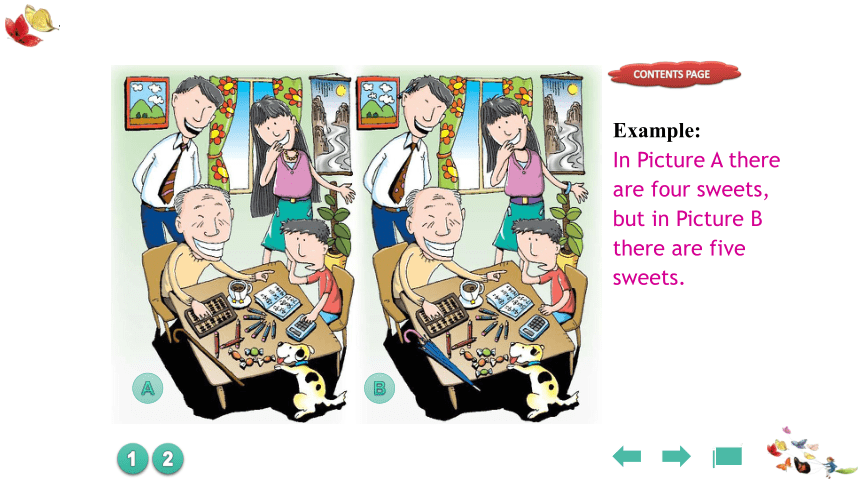
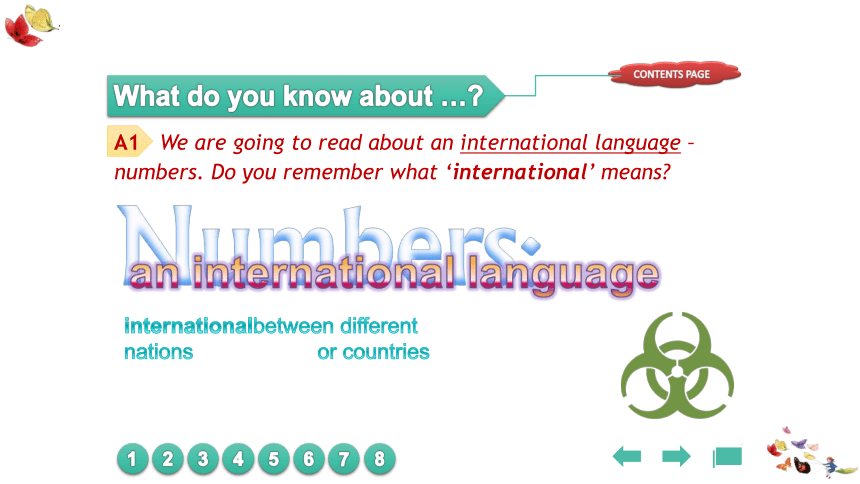

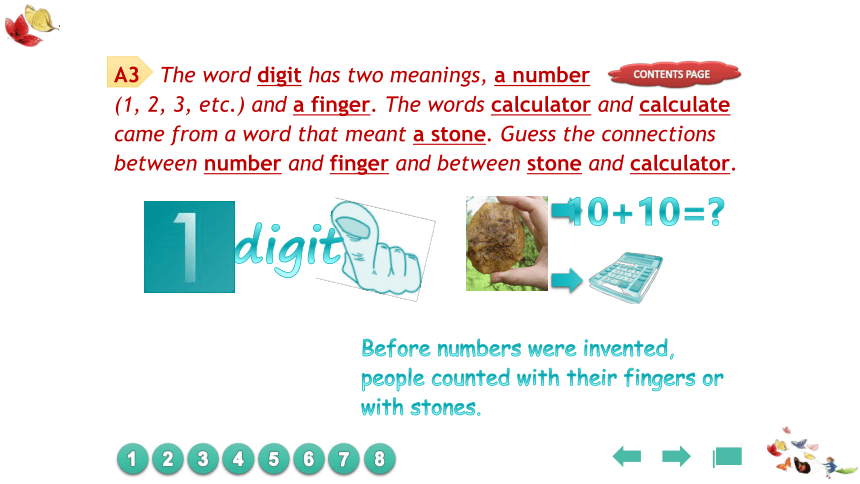
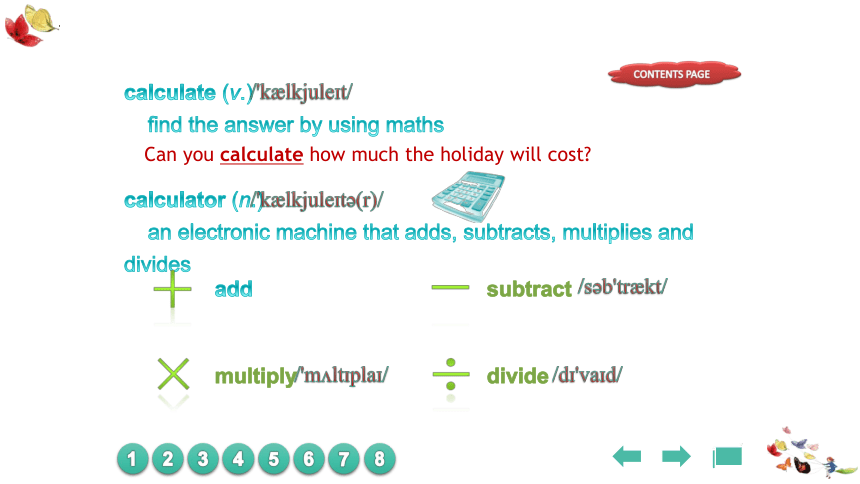
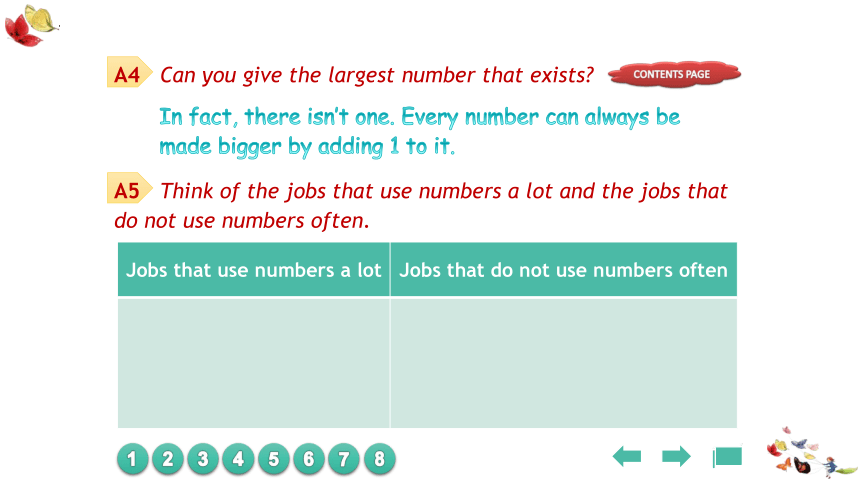
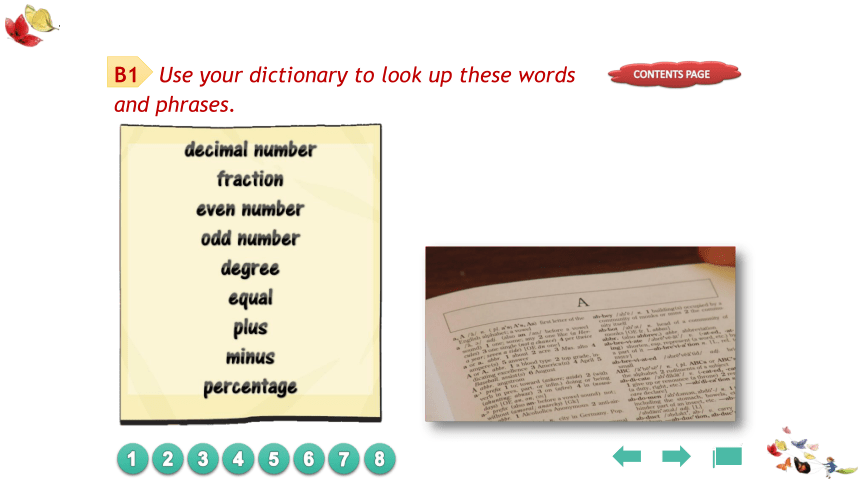
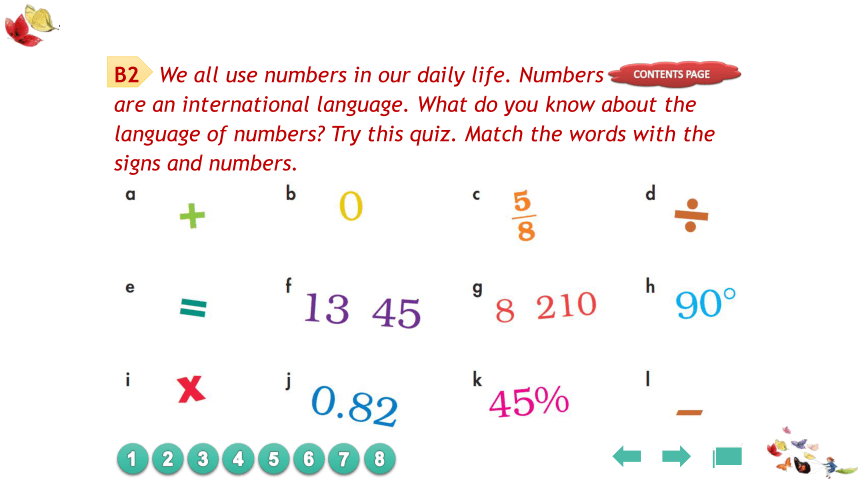
文档简介
(共43张PPT)
Unit4 Numbers!
Reading
Cartoon talk
1
2
Can animals count, Hi
My cat can!
How do you know, Hi
I asked it what 6 minus 6 was and it said nothing.
1
2
Answer the following questions.
What’s in Lo’s hand
What’s in Hi’s hands
Which question did Lo ask
What did Hi think
Do you think that animals can count
It’s an abacus.
It’s a cat.
He asked, ‘Can animals count ’
He thought his cat could count.
1
2
Puzzle time
In these two pictures, Grandad is helping Billy with his homework. Billy is using a calculator and Grandad is using an abacus. Mum and Dad are watching. Can you find 15 differences between the pictures Say and write a sentence about each of the differences.
1
2
A
B
Example:
In Picture A there are four sweets, but in Picture B there are five sweets.
1
2
What do you know about …
A1 We are going to read about an international language – numbers. Do you remember what ‘international’ means
3
4
5
international between different nations or countries
6
7
8
A2 Do you know what ‘language’ means
1
2
3
4
5
language (n.) words that a certain group of people say and write
/'l ɡw /
Do you know any international languages
6
7
8
A3 The word digit has two meanings, a number
(1, 2, 3, etc.) and a finger. The words calculator and calculate came from a word that meant a stone. Guess the connections between number and finger and between stone and calculator.
1
2
3
4
5
Before numbers were invented, people counted with their fingers or with stones.
digit
10+10=
6
7
8
1
2
3
4
5
calculate (v.)
find the answer by using maths
/'k lkjule t/
Can you calculate how much the holiday will cost
calculator (n.)
an electronic machine that adds, subtracts, multiplies and divides
/'k lkjule t (r)/
+
-
×
÷
add
subtract
multiply
divide
/s b'tr kt/
/'m lt pla /
/d 'va d/
6
7
8
1
2
3
4
5
A4 Can you give the largest number that exists
In fact, there isn’t one. Every number can always be made bigger by adding 1 to it.
A5 Think of the jobs that use numbers a lot and the jobs that do not use numbers often.
Jobs that use numbers a lot Jobs that do not use numbers often
6
7
8
1
2
3
4
5
B1 Use your dictionary to look up these words
and phrases.
6
7
8
1
2
3
4
5
B2 We all use numbers in our daily life. Numbers
are an international language. What do you know about the language of numbers Try this quiz. Match the words with the signs and numbers.
6
7
8
1 a decimal number 7 add; plus
2 equals 8 subtract; minus
3 a pair of odd numbers 9 multiply
4 a pair of even numbers 10 divide
5 a fraction 11 a number showing degrees
6 zero 12 a percentage
1
2
3
4
5
1
2
3
4
5
6
7
8
9
10
11
12
/d 'ɡri:/
/p 'sent /
6
7
8
1
2
Before you read
A Before you read the passage, look at the following pictures first. Put them in the order of the history of numbers. Then look at the headings on page 57 and check your answers.
3
0
1
2
3
This history of numbers
0
Ancient numbers
Zero
Calculating machines
Brain against computer
B Now, look at the title, the introduction, the
headings and the pictures. Then on the list below, tick ( ) the things you think the article may tell you.
1
2
3
Long ago, there were different ways of writing numbers.
Zero is not a number.
Zero is an especially important number.
Machines make it easier for us to calculate.
Your brain may calculate better than a computer.
Your brain is an important part of your body.
While you read
1
2
3
4
5
A1 Read the whole passage on page 57 for the first time. Find the following words or phrases in the passage. Work out their meanings by yourself.
6
7
8
9
10
11
nearly
system
invent
develop
invention
accurate
electronic
powerful
in a flash
calculation
whole
lifetime
living
human
following
amazing
solve
(like) lightning
program
above
12
13
14
15
16
A2 Choose the right meanings for these words.
nearly
a most
b almost
invented
a did not like
b made for the first time
accurate
a correct
b easy
1
2
3
4
5
6
7
8
9
10
11
12
13
14
15
16
1
2
3
4
5
6
7
8
9
10
11
12
13
14
15
16
in a flash
a in a long time
b in a short time
lifetime
a time that somebody works
b time that somebody lives
like lightning
a very quickly
b very slowly
1
2
3
4
5
6
7
8
9
10
11
12
13
14
15
16
A3 Match the words in Column A with the meanings in Column B.
A B 1 2 3 4 5 6 7 a system developed to calculate powerful amazing to solve lightning a b c d e f g make … bigger, better and stronger
very surprising
a group of things that work together
to use numbers to find answers
strong
very bright light in the sky
to find an answer to
1
2
3
4
5
6
7
8
9
10
11
12
13
14
15
16
A4 Write the words that go with the descriptions.
1
An ancient calculating machine that is still use today.
2
A living computer.
3
A small machine that uses electronic power to do calculations.
4
A very powerful machine for doing calculations.
An ____________.
The ____________.
A ____________.
A ____________.
abacus
brain
calculator
computer
1
2
3
4
5
6
7
8
9
10
11
12
13
14
15
16
B Read the passage.
How many languages do you know Everyone knows at least two—his or her own language and the international language of numbers.
1
2
3
4
5
6
7
8
9
10
11
12
13
14
15
16
In ancient times, people wrote numbers in many different ways, as these pictures of the number 6 show. However, they nearly all counted in the same way—in tens.
Ancient numbers
1
2
3
4
5
6
7
8
9
10
11
12
13
14
15
16
Zero
Most of us use the system of numbers with numbers from 1 to 9 and 0 (zero). With these ten numbers, we can write any number from the biggest to the smallest. The Indians first invented and developed the 1 to 9 system of numbers. They then invented the zero. This was a very important invention because it made it easier to write big numbers and to calculate.
1
2
3
4
5
6
7
8
9
10
11
12
13
14
15
16
Calculating machines
One of the first calculating machines was an abacus. Abacuses are so fast and accurate that people still use them today.
A modern electronic calculator can add, subtract, multiply and divide. It can also calculate percentages and square roots.
Computers are very powerful calculating machines. In a flash, a computer can do a calculation that you could not do in your whole lifetime.
Find the number that, when it is multiplied 23 times by itself, gives this answer:
916748676920039158098660927585380162483106680144308622407126516427934657040867096593279205767480806790022783016354924852380335745316935111903596577547340075681688305620821016129132845546805780158806771
1
2
3
4
5
6
7
8
9
10
11
12
13
14
15
16
Brain against computer
Some people call the brain a living computer. Is a human brain a more powerful calculator than a computer The following story may give an answer.
Shakuntala Devi is a lady from India with an amazing brain. Shakuntala and a very powerful computer were given this problem to solve.
1
2
3
4
5
6
7
8
9
10
11
12
13
14
15
16
Shakuntala’s brain took fifty seconds to find the answer, like lightning. The computer took a minute. However, someone had to first program the computer with instructions, and that took many hours. No one had to program Shakuntala!
Use your own living computer to solve the problem above. If it is not powerful enough, you will find the answer on page 67.
Answer: 546, 372, 891.
Passage
1
2
3
4
5
6
7
8
9
10
11
12
13
14
15
16
C May is asking Mr Li, the writer, some questions about his article on numbers. His answers are not quite clear. Read the article again and make his answers clearer. The first one has been done for you.
1
2
3
4
5
6
7
8
9
10
11
12
13
14
15
16
1 Mr Li: May: Mr Li: Everyone knows it.
Knows what
The ___________ of ___________.
2 Mr Li: May: Mr Li: Long ago, people wrote them in many different ways.
Wrote what
___________.
3 Mr Li: May: Mr Li: People all count in this way.
In what way
______________________.
4 Mr Li: May: Mr Li: The Indians invented that number.
Invented which number
___________.
language
numbers
Numbers
In tens
Zero
5 Mr Li: May: Mr Li: They’re so fast and accurate that people still use them today.
Still use what
___________.
6 Mr Li: May: Mr Li: Computers are very powerful ones.
Very powerful what
______________________.
7 Mr Li: May: Mr Li: It isn’t a machine. It’s a living computer.
What is a living computer
The ______________________.
8 Mr Li: May: Mr Li: Shakuntala beat one.
Beat what
A ___________.
Abacuses
Calculating machines
human brain
computer
1
2
3
4
5
6
7
8
9
10
11
12
13
14
15
16
D Complete answers to these questions about
Mr Li’s article. Work alone or in pairs.
1
2
3
4
5
6
7
8
9
10
11
12
13
14
15
16
Can you explain why we count in tens
We count in tens because we have __________ fingers.
Which did the Indians invent first, the 1 to 9 number system or the zero
They invented the ____________________________ first.
ten
1 to 9 number system
1
2
3
4
5
6
7
8
9
10
11
12
13
14
15
16
Can you complete this sentence with three words to tell us that a computer works very fast
A computer can do a calculation _____________.
Can you use two words to tell us that Shakuntala’s brain works very fast
It can do a calculation _____________.
Is a human brain a more powerful calculator than a computer Why
__________________________________________________________________________________________
in a flash
like lightning
(You can write your own answer here.)
After you read
A Work in pairs. Ask and answer question about Mr Li’s article on numbers. S1 asks the questions and S2 tries to answer his or her questions.
1
2
3
B Complete the summary.
1
2
3
Ancient numbers — In ancient times, people wrote numbers _______ ____________, but they are nearly counted _____________________.
Zero — Everyone uses the __________________ 1 to 9 plus 0 (zero). The __________ invented them. _________ makes it _________ to write big numbers and to calculate.
Calculating machines — The three calculating machines: the ____________, the ____________ and the ____________ make our life easier.
Brain against computer — There was once a competition between an Indian __________ and a __________ in which the __________ won. Computers cannot do anything by themselves. ___________________ must program them first.
in
different ways
in tens
number system
Indians
Zero
easier
abacuses
calculators
computers
lady
computer
lady
Human beings
C Say something about the history of numbers
according to the pictures below.
1
2
3
0
Using
Wang Xin, a Chinese student, and her good friend Mary, an American student studying Chinese in China. were in a supermarket. They saw a young man walking down the stairs. In his hurry, he missed the last two steps and fell onto the ground. He tried to stand up while people around him laughed. Luckily, he seemed to be OK.
Mary found Wang Xin laughing and Mary was unhappy about it. “Tell me, Wang Xin, how could people laugh when someone fell like that Why didn’t they go to ask him if he was hurt ”
Wang Xin said, “Because they knew he wasn’t hurt badly. If someone gets hurt seriously, people will not laugh. They will help him or her instead.”
“But I still don’t understand. A fall is a fall. In my country, people would never laugh!”
This is an example. The Chinese and the westerners will think and act differently when seeing such a thing. In that case, a westerner will rush over and help the person get up. If somebody falls, a Chinese person may try to make a joke if he or she is not hurt. If two close friends are walking together, and one falls but clearly isn’t hurt, common joke is to say “Have a nice trip”. So different people have different habits and different countries have different cultures.
根据材料内容选择最佳答案。
1.Who did NOT laugh when seeing the young man fall on the ground
A.Mary. B.Wang Xin. C.People around him. D.His friend.
2.Why did nobody ask the young man if he was hurt
A.Because people knew he wasn’t hurt too much.
B.Because people were worried to pay much money for him.
C.Because he got hurt seriously so that people were too afraid to ask him.
D.Because all people around the young man didn't know him.
3.Which of the following is TRUE according to the text
A.People in different countries have the same culture.
B.Wang Xin and Mary acted in the same way when the young man fell down.
C.Chinese people hardly laugh when they are in embarrassing situations.
D.When a westerner sees someone fall down, he or she will rush over to help him.
4.What might Wang Xin say to Mary if she falls but clearly is not hurt
A.You look pale. B.Anything else C.Have a nice trip. D.My pleasure.
5.Which best shows the structure of the story
A.①②/③/④⑤ B.①/②③/④⑤ C.①②/③④/⑤ D.①②③④/⑤
Keys
【答案】1.A 2.A 3.D 4.C 5.D
【导语】本文介绍了中西方的文化差异,面对一个人摔倒这一情况,中国人和西方人有着不同的思考和行动,中国人习惯大笑或微笑,在别人处于尴尬的情况还笑得出来,但西方人通常会过去帮忙,将其扶起来,因此不同的国家有不同的文化。
1.细节理解题。根据“Mary found Wang Xin laughing and Mary was unhappy about it.”可知,玛丽看到年轻人倒在地上时不笑。故选A。
2.细节理解题。根据“Because they knew he wasn’t hurt badly. If someone gets hurt seriously, people will not laugh. They will help him or her instead.”可知,因为人们知道他没有受到太大的伤害。故选A。
3.细节理解题。根据“In that case, a westerner will rush over and help the person get up.”可知,当西方人看到有人摔倒时,他或她会冲过去帮助他。故选D。
4.细节理解题。根据“If two close friends are walking together, and one falls but clearly isn’t hurt, common joke is to say “Have a nice trip”.”可知,如果玛丽摔倒了,但显然没有受伤,王欣会对她说“祝你旅途愉快”。故选C。
5.篇章结构。分析短文结构可知,①②③④四段属于并列关系,⑤段是总结,因此①②③④/⑤是正确的。故选D。
Using
Around the world, people have different ideas about what good table manners are. In India, for example, people only eat with their right hands. And their left hand stays still. Eating with your left hand is very rude (粗鲁的)!
In western countries, people do not usually share the same dishes. Everyone has his or her own plate of food. You eat with a knife and fork and you should not wave (挥) them around when you are not eating. And you should try not to be noisy when eating.
When you go to some restaurants in different parts of the world, it is important to know what people think is rude. For example, in China it is OK to be noisy in a restaurant. In fact, if a restaurant is not noisy, you may think it is not very good. However, in many western countries, restaurants are quiet places. If a table is too noisy, other customers might not be happy.
Paying for the meal is also different from country to country. In China, one person usually pays for everyone. In western countries, when friends eat together, they usually share the cost. This is called “going Dutch.” When westerners pay the check, they usually leave some money for the waiter. This is called “leaving a tip.” Not leaving a tip is very rude. In the U.S., it’s common to leave tips of 10%, 15% or 20% of the check.
6.What do people in western countries usually do while eating
A.Share the same dishes. B.Talk in a loud voice.
C.Wave knife and fork around. D.Eat food on their own plate.
7.What may people think if a restaurant in China is quiet
A.Few people come for meals. B.It’s a good place for eating.
C.The boss must be friendly. D.There are few dishes to taste.
8.If you pay for a 300-dollar bill in an American restaurant, how much will you leave as a tip
A.$15. B.$ 45. C.$ 75. D.$ 100.
9.Which of the following is TRUE
A.Indian people usually use both hands to eat.
B.Chinese people prefer sharing the cost for meals.
C.It’s rude to leave tips to the waiters in western countries.
D.In England, it’s impolite to make much noise while eating.
10.What is the best title for the text
A.Good Manners B.Eating Habits C.Mind Your Manners D.Pay for Meals
Keys
【答案】6.D 7.A 8.B 9.D 10.C
【导语】本文介绍了在世界各地,人们对什么是好的餐桌礼仪有不同的看法。
6.细节理解题。根据“In western countries, people do not usually share the same dishes. Everyone has his or her own plate of food.”可知,在西方国家,人们吃饭时吃自己的盘子里的食物,故选D。
7.推理判断题。根据“In fact, if a restaurant is not noisy, you may think it is not very good.”可知,如果一家餐馆不嘈杂,你可能会认为它不是很好。因此如果在中国一家餐馆非常安静,人们可能认为很少有人来吃饭,故选A。
8.推理判断题。根据“In the U.S., it’s common to leave tips of 10%, 15% or 20% of the check.”可知,在美国,小费通常是账单的10%、15%或20%。因此,如果你在美国餐馆付了300美元的账单,你会留下30、45或60美元作为小费,故选B。
9.推理判断题。根据“However, in many western countries, restaurants are quiet places. If a table is too noisy, other customers might not be happy.”可知,在许多西方国家,餐馆是安静的地方。如果一张桌子太吵,其他顾客可能会不高兴。因此在英国,吃饭时大声喧哗是不礼貌的。故选D。
10.标题归纳题。根据“Around the world, people have different ideas about what good table manners are.”可知,不同国家的人有不同的餐桌礼仪,因此本文主要告诉大家要注意你的礼貌,故选C。
Using
Long ago, there was a monster (怪物) called “Nian”. At the end of the winters, he often appeared in a village and ate the animals and villagers. The monster seemed very strong and nobody could fight him. So the villagers had to hide in the mountains to keep themselves safe.
One day, a smart old man came to the village. He told an old woman how to scare (把……吓跑) Nian away. That evening when Nian arrived at the village, he saw only the old woman’s house was bright. Nian got close to the house. Suddenly, he heard the noise of firecrackers (鞭炮). The monster felt afraid and jumped. And then he found the house was covered in red paper. This scared him even more and he ran out of the village quickly. When the other villagers returned, they saw that the old woman didn’t die!
The villagers later learned that Nian was afraid of red colors, light and loud noises. They decided to put up red couplets (对联), set off (点燃) firecrackers and stay up late when it was time for Nian’s visit at the end of winter. That is the legend (传奇) of how the Spring Festival celebration began.
11.Did Nian live in a village
12.What would happen when Nian visited the village
13.Why did the villagers hide into the mountains
14.From whom did the villager know the way to scare Nian away
15.What was Nian afraid of
Keys
【答案】11.No, he didn’t. 12.Nian would eat the animals and villagers. 13.To keep safe. 14.A smart old man. 15.Red colors, light and loud noises.
【导语】本文介绍了春节的来历,人们贴对联、放鞭炮、守岁是为了赶走“年”这个怪兽。
11.根据第一段“…there was a monster called ‘Nian’. At the end of the winters, he often appeared in a village and ate the animals and villagers.”(“年”这个怪物在冬天结束时,经常出现在村庄里,吃动物和村民)可知,“年”不住在村子里,作否定回答。故填No, he didn’t.
12.根据第一段“…there was a monster called ‘Nian’. At the end of the winters, he often appeared in a village and ate the animals and villagers.”可知,“年”到村庄会吃动物和村民。故填Nian would eat the animals and villagers.
13.根据第一段“The monster seemed very strong and nobody could fight him. So the villagers had to hide in the mountains to keep themselves safe.”(怪物看起来很强壮,没有人能和他战斗,村民们不得不躲在山里以保证自己的安全)可知,村民们躲进山里的原因是为了安全。故填To keep safe.
14.根据第二段“One day, a smart old man came to the village. He told an old woman how to scare Nian away.”可知,村民从一个聪明的老人那里知道如何把“年”吓跑。故填A smart old man.
15.根据第三段“The villagers later learned that Nian was afraid of red colors, light and loud noises.”可知,“年”害怕红色、亮光和巨大的噪音。故填Red colors, light and loud noises.
Using
Long time ago, there was a boy called Narcissus. He was very handsome and many women loved him. One of them was a fairy called Echo (回声). Unluckily, Echo could only repeat after others, so she couldn’t tell Narcissus her love for him.
One day, Narcissus got lost in the woods. He shouted, “Who’s there ” Echo repeated, “Who’s there ” Slowly, Echo stepped forward. But Narcissus didn’t love Echo, and left her heartbroken.
Later, a goddess learnt this. She decided to punish (惩罚) Narcissus. She made the boy fall in love with himself. Once Narcissus took a drink from a pond. He saw his own reflection (倒影) and fell in love with himself. From then on, he stayed there and looked into the water until he died. A flower grew where he died. That flower is called narcissus (水仙花).
This story tells us why the narcissus flower is seen as too much self-love. It also shows that too much self-love is unhealthy. What about healthy self-love To have healthy self-love, we need to use the mirror. That is to say, we need to love ourselves. Also, we need to find the goodness in others and love them. In this way, we will hear praise from each other. When we have learnt to appreciate the value that we add to each other’s lives, we can love ourselves healthily.
16.What does Narcissus mean in this passage
17.Could Echo tell Narcissus her love for him
18.How did Echo feel when Narcissus didn’t love her
19.How did the goddess punish Narcissus
20.What does the story tell us
21.What do we need to do to have healthy self-love
Keys
【答案】16.It means both the name of a boy and the name of a flower. 17.No, she couldn’t. 18.She felt heartbroken/sad. 19.She made the boy fall in love with himself. 20.The story tells us why the narcissus flower is seen as too much self-love and that too much self-love is unhealthy. 21.We need to love ourselves and to find the goodness in others and love them.
【导语】本文是一篇记叙文。文章通过讲述Narcissus的故事,告诉我们应该如何爱自己。
16.根据“there was a boy called Narcissus”和“That flower is called narcissus”可知是Narcissus一个帅气男孩的名字,也是一种花的名字,故填It means both the name of a boy and the name of a flower.
17.根据“Echo could only repeat after others, so she couldn’t tell Narcissus her love for him.”可知Echo不能表达自己的爱,故填No, she couldn’t.
18.根据“But Narcissus didn’t love Echo, and left her heartbroken.”可知Echo在被拒绝后感到心碎,感到伤心,故填She felt heartbroken/sad.
19.根据“Later, a goddess learnt this. She decided to punish Narcissus. She made the boy fall in love with himself. ”可知女神为了惩罚男孩,让他爱上了自己,故填She made the boy fall in love with himself.
20.根据“This story tells us why the narcissus flower is seen as too much self-love. It also shows that too much self-love is unhealthy.”可知故事告诉我们为什么水仙花被看作太自恋和太自恋是不健康的,故填The story tells us why the narcissus flower is seen as too much self-love and that too much self-love is unhealthy.
21.根据“To have healthy self-love, we need to use the mirror. That is to say, we need to love ourselves. Also, we need to find the goodness in others and love them.”可知健康的自爱需要我们爱我们自己并发现别人的美德,爱他们。故填We need to love ourselves and to find the goodness in others and love them.
Unit4 Numbers!
Reading
Cartoon talk
1
2
Can animals count, Hi
My cat can!
How do you know, Hi
I asked it what 6 minus 6 was and it said nothing.
1
2
Answer the following questions.
What’s in Lo’s hand
What’s in Hi’s hands
Which question did Lo ask
What did Hi think
Do you think that animals can count
It’s an abacus.
It’s a cat.
He asked, ‘Can animals count ’
He thought his cat could count.
1
2
Puzzle time
In these two pictures, Grandad is helping Billy with his homework. Billy is using a calculator and Grandad is using an abacus. Mum and Dad are watching. Can you find 15 differences between the pictures Say and write a sentence about each of the differences.
1
2
A
B
Example:
In Picture A there are four sweets, but in Picture B there are five sweets.
1
2
What do you know about …
A1 We are going to read about an international language – numbers. Do you remember what ‘international’ means
3
4
5
international between different nations or countries
6
7
8
A2 Do you know what ‘language’ means
1
2
3
4
5
language (n.) words that a certain group of people say and write
/'l ɡw /
Do you know any international languages
6
7
8
A3 The word digit has two meanings, a number
(1, 2, 3, etc.) and a finger. The words calculator and calculate came from a word that meant a stone. Guess the connections between number and finger and between stone and calculator.
1
2
3
4
5
Before numbers were invented, people counted with their fingers or with stones.
digit
10+10=
6
7
8
1
2
3
4
5
calculate (v.)
find the answer by using maths
/'k lkjule t/
Can you calculate how much the holiday will cost
calculator (n.)
an electronic machine that adds, subtracts, multiplies and divides
/'k lkjule t (r)/
+
-
×
÷
add
subtract
multiply
divide
/s b'tr kt/
/'m lt pla /
/d 'va d/
6
7
8
1
2
3
4
5
A4 Can you give the largest number that exists
In fact, there isn’t one. Every number can always be made bigger by adding 1 to it.
A5 Think of the jobs that use numbers a lot and the jobs that do not use numbers often.
Jobs that use numbers a lot Jobs that do not use numbers often
6
7
8
1
2
3
4
5
B1 Use your dictionary to look up these words
and phrases.
6
7
8
1
2
3
4
5
B2 We all use numbers in our daily life. Numbers
are an international language. What do you know about the language of numbers Try this quiz. Match the words with the signs and numbers.
6
7
8
1 a decimal number 7 add; plus
2 equals 8 subtract; minus
3 a pair of odd numbers 9 multiply
4 a pair of even numbers 10 divide
5 a fraction 11 a number showing degrees
6 zero 12 a percentage
1
2
3
4
5
1
2
3
4
5
6
7
8
9
10
11
12
/d 'ɡri:/
/p 'sent /
6
7
8
1
2
Before you read
A Before you read the passage, look at the following pictures first. Put them in the order of the history of numbers. Then look at the headings on page 57 and check your answers.
3
0
1
2
3
This history of numbers
0
Ancient numbers
Zero
Calculating machines
Brain against computer
B Now, look at the title, the introduction, the
headings and the pictures. Then on the list below, tick ( ) the things you think the article may tell you.
1
2
3
Long ago, there were different ways of writing numbers.
Zero is not a number.
Zero is an especially important number.
Machines make it easier for us to calculate.
Your brain may calculate better than a computer.
Your brain is an important part of your body.
While you read
1
2
3
4
5
A1 Read the whole passage on page 57 for the first time. Find the following words or phrases in the passage. Work out their meanings by yourself.
6
7
8
9
10
11
nearly
system
invent
develop
invention
accurate
electronic
powerful
in a flash
calculation
whole
lifetime
living
human
following
amazing
solve
(like) lightning
program
above
12
13
14
15
16
A2 Choose the right meanings for these words.
nearly
a most
b almost
invented
a did not like
b made for the first time
accurate
a correct
b easy
1
2
3
4
5
6
7
8
9
10
11
12
13
14
15
16
1
2
3
4
5
6
7
8
9
10
11
12
13
14
15
16
in a flash
a in a long time
b in a short time
lifetime
a time that somebody works
b time that somebody lives
like lightning
a very quickly
b very slowly
1
2
3
4
5
6
7
8
9
10
11
12
13
14
15
16
A3 Match the words in Column A with the meanings in Column B.
A B 1 2 3 4 5 6 7 a system developed to calculate powerful amazing to solve lightning a b c d e f g make … bigger, better and stronger
very surprising
a group of things that work together
to use numbers to find answers
strong
very bright light in the sky
to find an answer to
1
2
3
4
5
6
7
8
9
10
11
12
13
14
15
16
A4 Write the words that go with the descriptions.
1
An ancient calculating machine that is still use today.
2
A living computer.
3
A small machine that uses electronic power to do calculations.
4
A very powerful machine for doing calculations.
An ____________.
The ____________.
A ____________.
A ____________.
abacus
brain
calculator
computer
1
2
3
4
5
6
7
8
9
10
11
12
13
14
15
16
B Read the passage.
How many languages do you know Everyone knows at least two—his or her own language and the international language of numbers.
1
2
3
4
5
6
7
8
9
10
11
12
13
14
15
16
In ancient times, people wrote numbers in many different ways, as these pictures of the number 6 show. However, they nearly all counted in the same way—in tens.
Ancient numbers
1
2
3
4
5
6
7
8
9
10
11
12
13
14
15
16
Zero
Most of us use the system of numbers with numbers from 1 to 9 and 0 (zero). With these ten numbers, we can write any number from the biggest to the smallest. The Indians first invented and developed the 1 to 9 system of numbers. They then invented the zero. This was a very important invention because it made it easier to write big numbers and to calculate.
1
2
3
4
5
6
7
8
9
10
11
12
13
14
15
16
Calculating machines
One of the first calculating machines was an abacus. Abacuses are so fast and accurate that people still use them today.
A modern electronic calculator can add, subtract, multiply and divide. It can also calculate percentages and square roots.
Computers are very powerful calculating machines. In a flash, a computer can do a calculation that you could not do in your whole lifetime.
Find the number that, when it is multiplied 23 times by itself, gives this answer:
916748676920039158098660927585380162483106680144308622407126516427934657040867096593279205767480806790022783016354924852380335745316935111903596577547340075681688305620821016129132845546805780158806771
1
2
3
4
5
6
7
8
9
10
11
12
13
14
15
16
Brain against computer
Some people call the brain a living computer. Is a human brain a more powerful calculator than a computer The following story may give an answer.
Shakuntala Devi is a lady from India with an amazing brain. Shakuntala and a very powerful computer were given this problem to solve.
1
2
3
4
5
6
7
8
9
10
11
12
13
14
15
16
Shakuntala’s brain took fifty seconds to find the answer, like lightning. The computer took a minute. However, someone had to first program the computer with instructions, and that took many hours. No one had to program Shakuntala!
Use your own living computer to solve the problem above. If it is not powerful enough, you will find the answer on page 67.
Answer: 546, 372, 891.
Passage
1
2
3
4
5
6
7
8
9
10
11
12
13
14
15
16
C May is asking Mr Li, the writer, some questions about his article on numbers. His answers are not quite clear. Read the article again and make his answers clearer. The first one has been done for you.
1
2
3
4
5
6
7
8
9
10
11
12
13
14
15
16
1 Mr Li: May: Mr Li: Everyone knows it.
Knows what
The ___________ of ___________.
2 Mr Li: May: Mr Li: Long ago, people wrote them in many different ways.
Wrote what
___________.
3 Mr Li: May: Mr Li: People all count in this way.
In what way
______________________.
4 Mr Li: May: Mr Li: The Indians invented that number.
Invented which number
___________.
language
numbers
Numbers
In tens
Zero
5 Mr Li: May: Mr Li: They’re so fast and accurate that people still use them today.
Still use what
___________.
6 Mr Li: May: Mr Li: Computers are very powerful ones.
Very powerful what
______________________.
7 Mr Li: May: Mr Li: It isn’t a machine. It’s a living computer.
What is a living computer
The ______________________.
8 Mr Li: May: Mr Li: Shakuntala beat one.
Beat what
A ___________.
Abacuses
Calculating machines
human brain
computer
1
2
3
4
5
6
7
8
9
10
11
12
13
14
15
16
D Complete answers to these questions about
Mr Li’s article. Work alone or in pairs.
1
2
3
4
5
6
7
8
9
10
11
12
13
14
15
16
Can you explain why we count in tens
We count in tens because we have __________ fingers.
Which did the Indians invent first, the 1 to 9 number system or the zero
They invented the ____________________________ first.
ten
1 to 9 number system
1
2
3
4
5
6
7
8
9
10
11
12
13
14
15
16
Can you complete this sentence with three words to tell us that a computer works very fast
A computer can do a calculation _____________.
Can you use two words to tell us that Shakuntala’s brain works very fast
It can do a calculation _____________.
Is a human brain a more powerful calculator than a computer Why
__________________________________________________________________________________________
in a flash
like lightning
(You can write your own answer here.)
After you read
A Work in pairs. Ask and answer question about Mr Li’s article on numbers. S1 asks the questions and S2 tries to answer his or her questions.
1
2
3
B Complete the summary.
1
2
3
Ancient numbers — In ancient times, people wrote numbers _______ ____________, but they are nearly counted _____________________.
Zero — Everyone uses the __________________ 1 to 9 plus 0 (zero). The __________ invented them. _________ makes it _________ to write big numbers and to calculate.
Calculating machines — The three calculating machines: the ____________, the ____________ and the ____________ make our life easier.
Brain against computer — There was once a competition between an Indian __________ and a __________ in which the __________ won. Computers cannot do anything by themselves. ___________________ must program them first.
in
different ways
in tens
number system
Indians
Zero
easier
abacuses
calculators
computers
lady
computer
lady
Human beings
C Say something about the history of numbers
according to the pictures below.
1
2
3
0
Using
Wang Xin, a Chinese student, and her good friend Mary, an American student studying Chinese in China. were in a supermarket. They saw a young man walking down the stairs. In his hurry, he missed the last two steps and fell onto the ground. He tried to stand up while people around him laughed. Luckily, he seemed to be OK.
Mary found Wang Xin laughing and Mary was unhappy about it. “Tell me, Wang Xin, how could people laugh when someone fell like that Why didn’t they go to ask him if he was hurt ”
Wang Xin said, “Because they knew he wasn’t hurt badly. If someone gets hurt seriously, people will not laugh. They will help him or her instead.”
“But I still don’t understand. A fall is a fall. In my country, people would never laugh!”
This is an example. The Chinese and the westerners will think and act differently when seeing such a thing. In that case, a westerner will rush over and help the person get up. If somebody falls, a Chinese person may try to make a joke if he or she is not hurt. If two close friends are walking together, and one falls but clearly isn’t hurt, common joke is to say “Have a nice trip”. So different people have different habits and different countries have different cultures.
根据材料内容选择最佳答案。
1.Who did NOT laugh when seeing the young man fall on the ground
A.Mary. B.Wang Xin. C.People around him. D.His friend.
2.Why did nobody ask the young man if he was hurt
A.Because people knew he wasn’t hurt too much.
B.Because people were worried to pay much money for him.
C.Because he got hurt seriously so that people were too afraid to ask him.
D.Because all people around the young man didn't know him.
3.Which of the following is TRUE according to the text
A.People in different countries have the same culture.
B.Wang Xin and Mary acted in the same way when the young man fell down.
C.Chinese people hardly laugh when they are in embarrassing situations.
D.When a westerner sees someone fall down, he or she will rush over to help him.
4.What might Wang Xin say to Mary if she falls but clearly is not hurt
A.You look pale. B.Anything else C.Have a nice trip. D.My pleasure.
5.Which best shows the structure of the story
A.①②/③/④⑤ B.①/②③/④⑤ C.①②/③④/⑤ D.①②③④/⑤
Keys
【答案】1.A 2.A 3.D 4.C 5.D
【导语】本文介绍了中西方的文化差异,面对一个人摔倒这一情况,中国人和西方人有着不同的思考和行动,中国人习惯大笑或微笑,在别人处于尴尬的情况还笑得出来,但西方人通常会过去帮忙,将其扶起来,因此不同的国家有不同的文化。
1.细节理解题。根据“Mary found Wang Xin laughing and Mary was unhappy about it.”可知,玛丽看到年轻人倒在地上时不笑。故选A。
2.细节理解题。根据“Because they knew he wasn’t hurt badly. If someone gets hurt seriously, people will not laugh. They will help him or her instead.”可知,因为人们知道他没有受到太大的伤害。故选A。
3.细节理解题。根据“In that case, a westerner will rush over and help the person get up.”可知,当西方人看到有人摔倒时,他或她会冲过去帮助他。故选D。
4.细节理解题。根据“If two close friends are walking together, and one falls but clearly isn’t hurt, common joke is to say “Have a nice trip”.”可知,如果玛丽摔倒了,但显然没有受伤,王欣会对她说“祝你旅途愉快”。故选C。
5.篇章结构。分析短文结构可知,①②③④四段属于并列关系,⑤段是总结,因此①②③④/⑤是正确的。故选D。
Using
Around the world, people have different ideas about what good table manners are. In India, for example, people only eat with their right hands. And their left hand stays still. Eating with your left hand is very rude (粗鲁的)!
In western countries, people do not usually share the same dishes. Everyone has his or her own plate of food. You eat with a knife and fork and you should not wave (挥) them around when you are not eating. And you should try not to be noisy when eating.
When you go to some restaurants in different parts of the world, it is important to know what people think is rude. For example, in China it is OK to be noisy in a restaurant. In fact, if a restaurant is not noisy, you may think it is not very good. However, in many western countries, restaurants are quiet places. If a table is too noisy, other customers might not be happy.
Paying for the meal is also different from country to country. In China, one person usually pays for everyone. In western countries, when friends eat together, they usually share the cost. This is called “going Dutch.” When westerners pay the check, they usually leave some money for the waiter. This is called “leaving a tip.” Not leaving a tip is very rude. In the U.S., it’s common to leave tips of 10%, 15% or 20% of the check.
6.What do people in western countries usually do while eating
A.Share the same dishes. B.Talk in a loud voice.
C.Wave knife and fork around. D.Eat food on their own plate.
7.What may people think if a restaurant in China is quiet
A.Few people come for meals. B.It’s a good place for eating.
C.The boss must be friendly. D.There are few dishes to taste.
8.If you pay for a 300-dollar bill in an American restaurant, how much will you leave as a tip
A.$15. B.$ 45. C.$ 75. D.$ 100.
9.Which of the following is TRUE
A.Indian people usually use both hands to eat.
B.Chinese people prefer sharing the cost for meals.
C.It’s rude to leave tips to the waiters in western countries.
D.In England, it’s impolite to make much noise while eating.
10.What is the best title for the text
A.Good Manners B.Eating Habits C.Mind Your Manners D.Pay for Meals
Keys
【答案】6.D 7.A 8.B 9.D 10.C
【导语】本文介绍了在世界各地,人们对什么是好的餐桌礼仪有不同的看法。
6.细节理解题。根据“In western countries, people do not usually share the same dishes. Everyone has his or her own plate of food.”可知,在西方国家,人们吃饭时吃自己的盘子里的食物,故选D。
7.推理判断题。根据“In fact, if a restaurant is not noisy, you may think it is not very good.”可知,如果一家餐馆不嘈杂,你可能会认为它不是很好。因此如果在中国一家餐馆非常安静,人们可能认为很少有人来吃饭,故选A。
8.推理判断题。根据“In the U.S., it’s common to leave tips of 10%, 15% or 20% of the check.”可知,在美国,小费通常是账单的10%、15%或20%。因此,如果你在美国餐馆付了300美元的账单,你会留下30、45或60美元作为小费,故选B。
9.推理判断题。根据“However, in many western countries, restaurants are quiet places. If a table is too noisy, other customers might not be happy.”可知,在许多西方国家,餐馆是安静的地方。如果一张桌子太吵,其他顾客可能会不高兴。因此在英国,吃饭时大声喧哗是不礼貌的。故选D。
10.标题归纳题。根据“Around the world, people have different ideas about what good table manners are.”可知,不同国家的人有不同的餐桌礼仪,因此本文主要告诉大家要注意你的礼貌,故选C。
Using
Long ago, there was a monster (怪物) called “Nian”. At the end of the winters, he often appeared in a village and ate the animals and villagers. The monster seemed very strong and nobody could fight him. So the villagers had to hide in the mountains to keep themselves safe.
One day, a smart old man came to the village. He told an old woman how to scare (把……吓跑) Nian away. That evening when Nian arrived at the village, he saw only the old woman’s house was bright. Nian got close to the house. Suddenly, he heard the noise of firecrackers (鞭炮). The monster felt afraid and jumped. And then he found the house was covered in red paper. This scared him even more and he ran out of the village quickly. When the other villagers returned, they saw that the old woman didn’t die!
The villagers later learned that Nian was afraid of red colors, light and loud noises. They decided to put up red couplets (对联), set off (点燃) firecrackers and stay up late when it was time for Nian’s visit at the end of winter. That is the legend (传奇) of how the Spring Festival celebration began.
11.Did Nian live in a village
12.What would happen when Nian visited the village
13.Why did the villagers hide into the mountains
14.From whom did the villager know the way to scare Nian away
15.What was Nian afraid of
Keys
【答案】11.No, he didn’t. 12.Nian would eat the animals and villagers. 13.To keep safe. 14.A smart old man. 15.Red colors, light and loud noises.
【导语】本文介绍了春节的来历,人们贴对联、放鞭炮、守岁是为了赶走“年”这个怪兽。
11.根据第一段“…there was a monster called ‘Nian’. At the end of the winters, he often appeared in a village and ate the animals and villagers.”(“年”这个怪物在冬天结束时,经常出现在村庄里,吃动物和村民)可知,“年”不住在村子里,作否定回答。故填No, he didn’t.
12.根据第一段“…there was a monster called ‘Nian’. At the end of the winters, he often appeared in a village and ate the animals and villagers.”可知,“年”到村庄会吃动物和村民。故填Nian would eat the animals and villagers.
13.根据第一段“The monster seemed very strong and nobody could fight him. So the villagers had to hide in the mountains to keep themselves safe.”(怪物看起来很强壮,没有人能和他战斗,村民们不得不躲在山里以保证自己的安全)可知,村民们躲进山里的原因是为了安全。故填To keep safe.
14.根据第二段“One day, a smart old man came to the village. He told an old woman how to scare Nian away.”可知,村民从一个聪明的老人那里知道如何把“年”吓跑。故填A smart old man.
15.根据第三段“The villagers later learned that Nian was afraid of red colors, light and loud noises.”可知,“年”害怕红色、亮光和巨大的噪音。故填Red colors, light and loud noises.
Using
Long time ago, there was a boy called Narcissus. He was very handsome and many women loved him. One of them was a fairy called Echo (回声). Unluckily, Echo could only repeat after others, so she couldn’t tell Narcissus her love for him.
One day, Narcissus got lost in the woods. He shouted, “Who’s there ” Echo repeated, “Who’s there ” Slowly, Echo stepped forward. But Narcissus didn’t love Echo, and left her heartbroken.
Later, a goddess learnt this. She decided to punish (惩罚) Narcissus. She made the boy fall in love with himself. Once Narcissus took a drink from a pond. He saw his own reflection (倒影) and fell in love with himself. From then on, he stayed there and looked into the water until he died. A flower grew where he died. That flower is called narcissus (水仙花).
This story tells us why the narcissus flower is seen as too much self-love. It also shows that too much self-love is unhealthy. What about healthy self-love To have healthy self-love, we need to use the mirror. That is to say, we need to love ourselves. Also, we need to find the goodness in others and love them. In this way, we will hear praise from each other. When we have learnt to appreciate the value that we add to each other’s lives, we can love ourselves healthily.
16.What does Narcissus mean in this passage
17.Could Echo tell Narcissus her love for him
18.How did Echo feel when Narcissus didn’t love her
19.How did the goddess punish Narcissus
20.What does the story tell us
21.What do we need to do to have healthy self-love
Keys
【答案】16.It means both the name of a boy and the name of a flower. 17.No, she couldn’t. 18.She felt heartbroken/sad. 19.She made the boy fall in love with himself. 20.The story tells us why the narcissus flower is seen as too much self-love and that too much self-love is unhealthy. 21.We need to love ourselves and to find the goodness in others and love them.
【导语】本文是一篇记叙文。文章通过讲述Narcissus的故事,告诉我们应该如何爱自己。
16.根据“there was a boy called Narcissus”和“That flower is called narcissus”可知是Narcissus一个帅气男孩的名字,也是一种花的名字,故填It means both the name of a boy and the name of a flower.
17.根据“Echo could only repeat after others, so she couldn’t tell Narcissus her love for him.”可知Echo不能表达自己的爱,故填No, she couldn’t.
18.根据“But Narcissus didn’t love Echo, and left her heartbroken.”可知Echo在被拒绝后感到心碎,感到伤心,故填She felt heartbroken/sad.
19.根据“Later, a goddess learnt this. She decided to punish Narcissus. She made the boy fall in love with himself. ”可知女神为了惩罚男孩,让他爱上了自己,故填She made the boy fall in love with himself.
20.根据“This story tells us why the narcissus flower is seen as too much self-love. It also shows that too much self-love is unhealthy.”可知故事告诉我们为什么水仙花被看作太自恋和太自恋是不健康的,故填The story tells us why the narcissus flower is seen as too much self-love and that too much self-love is unhealthy.
21.根据“To have healthy self-love, we need to use the mirror. That is to say, we need to love ourselves. Also, we need to find the goodness in others and love them.”可知健康的自爱需要我们爱我们自己并发现别人的美德,爱他们。故填We need to love ourselves and to find the goodness in others and love them.
